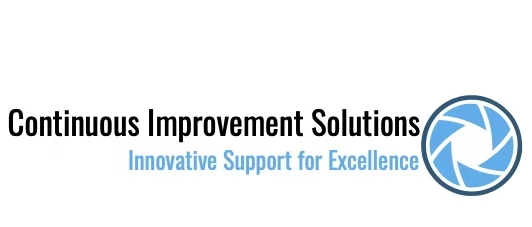Struggling with low morale, high turnover, or disengaged employees?
You’re not alone.
Employee engagement is the key to building a motivated team. Whether you’re a manager, business owner, or HR professional, understanding how to keep employees connected and invested in their work can transform your workplace.
Let’s explore simple ways to boost engagement and create a thriving company culture.
Introduction to Employee Engagement
Employee engagement is the center of a thriving workplace.
Employee engagement is about more than just job satisfaction. it’s about how connected, committed, and motivated your employees feel in their roles.
Businesses are realizing that engaged employees are the key to success. Studies show that highly engaged teams lead to 21% greater profitability and 17% higher productivity (Gallup, 2020). Additionally, companies with strong engagement see 59% lower turnover in low-turnover industries (Gallup, 2017).
A 59% lower turnover is drastic!
Imagine a company had 100 employees, and about 20 employees left each year.
Then this company spent the last year focusing on employee engagement and experienced the 59% lower turnover rate.
Now, instead of 20 employees leaving, only 8 or 9 employees leave each year.
That is a huge difference!
But what exactly is employee engagement, and why does it matter?
Let’s break it down.
Why is Employee Engagement Important?
Everyone wants to be on a team where everyone is invested and everyone is on the same page.
It’s energizing. You feel motivated, and you actually enjoy what you’re doing.
That’s what employee engagement is all about. Employee engagement is how enthusiastic and committed a worker is to their job and company.
When employees are engaged, they go above and beyond, and it’s not just for the paycheck. They’re more creative, more productive, and they help the company thrive.
Sounds pretty good, right?
But when employees aren’t engaged, often they’re just punching the clock.
They complete their job, but that’s about it. And unfortunately, this disengagement costs businesses billions in lost productivity every year.
So yeah, engagement matters; not just for employees, but for the bottom line.
Who is Responsible for Employee Engagement?
Everyone.
- Leaders & Managers set the tone. When they support, listen, and recognize hard work, employees feel valued and motivated.
- HR & Culture Teams ensure a positive work environment. They address concerns like benefits and work-life balance, creating a space where engagement can thrive.
- Employees play a key role too. Engagement is a two-way street. Those who take ownership, contribute, and support each other help build a strong culture.
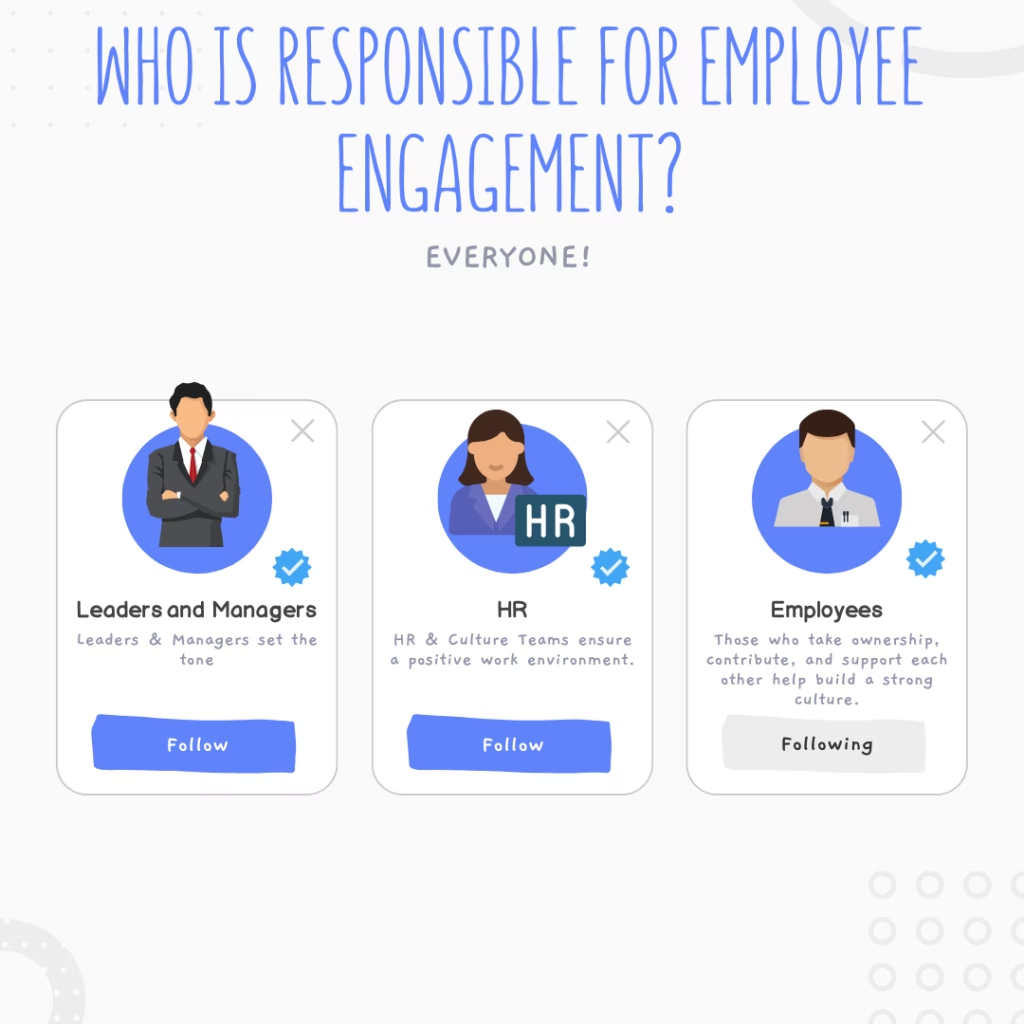
When leadership leads by example, HR fosters a supportive culture, and employees bring their best, engagement flourishes.
Identifying Employee Engagement
Think about a time when you felt completely in the zone at work. When you were fully absorbed in a project, the hours flew by, and you couldn’t wait to dive back in the next day.
That’s what employee engagement looks like.
But how do you spot when employees are truly engaged? Or when they’re checking out mentally?
Signs of Engaged vs. Disengaged Employees
Engagement looks different for everyone.
An extroverted employee might show enthusiasm through energetic discussions, while an introverted employee might demonstrate engagement through thoughtful, detailed work and carefully considered contributions.
The biggest indicator if an employee is engaged is to know their personality beforehand and be mindful of changes in their behavior.
With that said, here are some basics of what an engaged vs. disengaged employee looks like.
Engaged Employees
They stand out through their approach to work and interactions with their team:
- Take Real Initiative: For an extrovert, this might mean speaking up in meetings. For an introvert, it could mean developing a detailed improvement plan or solving a problem independently.
- Show Genuine Passion: An extroverted employee might visibly celebrate team wins, while an introverted employee might show passion through consistently high-quality work and deep focus.
When a challenging project lands on their desk, an engaged employee sees it as an opportunity to learn, grow, and make a meaningful impact.
Key behaviors include:
- Contributing in ways that align with their natural communication style
- Demonstrating commitment through actions, not just volume
- Showing genuine interest in team and company goals
Disengaged Employees
Disengaged employees are like quiet shadows in the workplace. They complete tasks, but without any real commitment or energy:
- Do the Bare Minimum: These employees do just enough to get by, regardless of their personality type.
- Lack Enthusiasm: Their lack of engagement shows through minimal effort and commitment, whether they’re naturally quiet or outgoing.
A disengaged employee might complete all assigned tasks, but they won’t contribute anything extra. They’re present physically but absent mentally.
Warning signs include:
- No meaningful contribution to team goals
- Consistent lack of initiative
- Minimal investment in personal or team growth
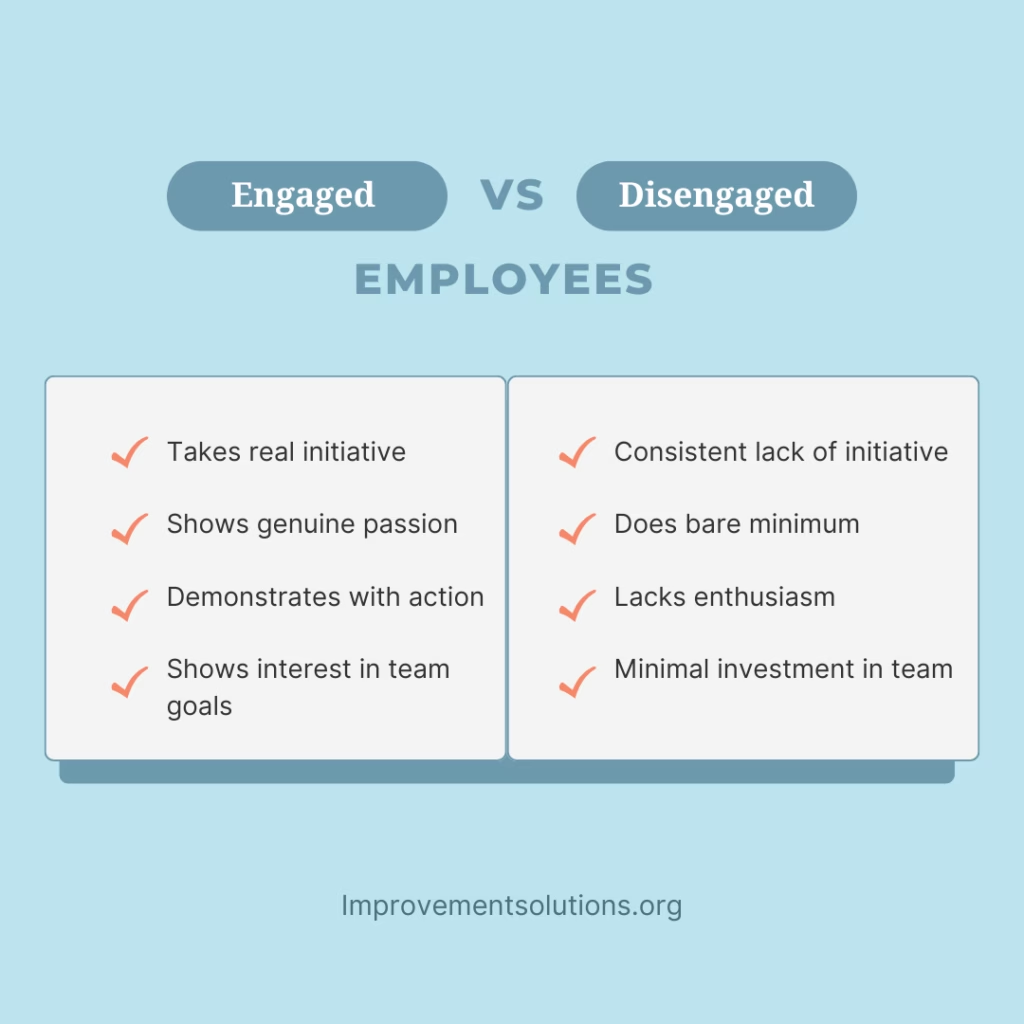
Strategies for Enhancing Employee Engagement
So, how do you go from spotting disengaged employees to creating an environment where everyone feels energized and committed?
It all starts with the right strategies.
Here’s how you can kick-start employee engagement, starting at the individual level.
Individual Level Engagement Strategies
When it comes to engagement, it’s easy to think that it’s all about what the company offers.
But the truth is, individual efforts matter too.
Each person’s actions and mindset can play an essential role in creating a more engaged workplace.
Let’s dive into one of the most effective strategies for driving engagement at the individual level:
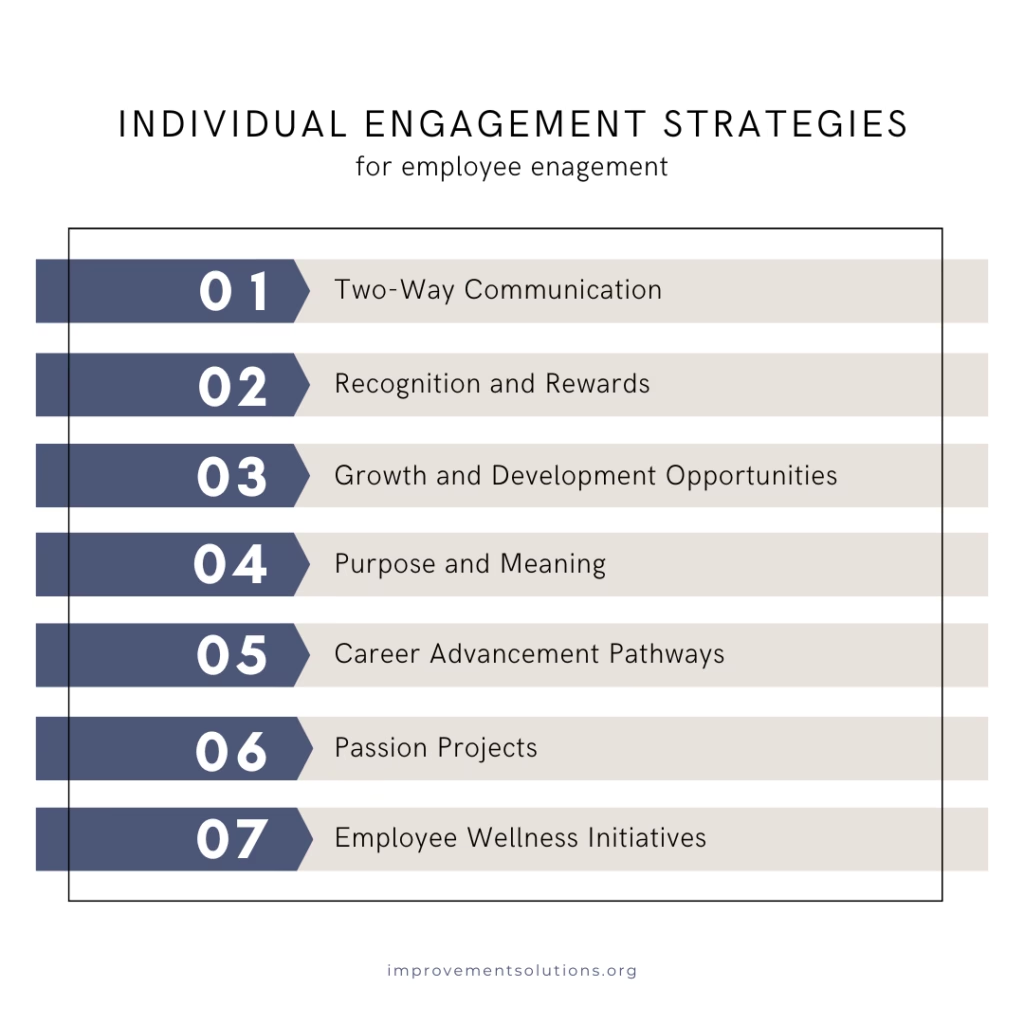
Two-Way Communication
Think of communication like a two-way street.
If only one side is doing all the talking, it’s bound to get frustrating and one-sided. It’s the same with employee engagement.
A key strategy for keeping employees engaged is ensuring there’s an open, ongoing conversation between them and their managers, colleagues, and even leadership.
What does this look like in action?
Employees don’t just want to hear from you. They want to share their thoughts, too.
Make feedback a regular part of your team’s routine, whether it’s through one-on-ones, surveys, or quick check-ins.
Ask questions like, “What’s working for you right now?” or “Is there anything you need more support with?” This shows employees that their voices matter.
Keeping the lines of communication open also means sharing information, not just collecting it.
Let employees know the “why” behind decisions and keep them in the loop on the direction the company is heading.
When employees feel like they’re part of the bigger picture, they’re more likely to be engaged.
Another big part of two-way communication is trust.
Encourage an environment where employees can speak up without fear of judgment or retaliation. Whether it’s offering anonymous channels for feedback or hosting regular team discussions, give employees a platform to share their thoughts freely.
Recognition and Rewards
Everyone likes to feel appreciated.
It’s one of those simple, yet powerful emotions that can transform an employee’s experience at work.
When employees feel valued, they’re more likely to stay motivated and committed.
What does recognition and rewards look like?
Recognize both big and small wins.
Whether it’s celebrating the completion of a challenging project or acknowledging an employee’s everyday effort, taking the time to highlight achievements makes a significant difference.
This doesn’t always need to be a special event; just a simple “great job” in a meeting or a thank-you note can go a long way.
People appreciate specific feedback, so it’s important to personalize your rewards.
Some employees may prefer public recognition, while others might prefer a private thank-you or even a small token of appreciation, like a gift card or extra time off.
Understanding what motivates each individual can make your recognition efforts meaningful.
Furthermore, linking rewards to company values makes them even more impactful.
If one of your company values is teamwork, reward collaborative efforts.
When rewards are connected to shared goals, they reinforce the behaviors that matter most.
Growth and Development Opportunities
A stagnant job can quickly lead to disengagement.
But when employees feel like they’re growing and developing, they’re more likely to be excited about their work.
Providing growth opportunities is a game-changer when it comes to engagement.
What growth and development strategies work?
Whether it’s through workshops, training sessions, or access to courses, giving employees opportunities to expand their skills shows that you’re invested in their personal and professional growth.
Encourage employees to pursue interests that will help them in their current roles or future ones.
Offering employees the chance to learn about other roles or departments can keep things exciting and help them build new skills.
Cross-training allows employees to feel connected to the larger mission of the company and gives them a broader perspective of how everything fits together.
Pairing employees with mentors can provide them with guidance and insight that fosters their career growth.
Mentorship isn’t just about teaching, it’s about building a relationship that supports growth on both sides.
Purpose and Meaning
People want to feel like their work matters.
When employees see how their work contributes to something bigger, it can reignite their passion and commitment.
A sense of purpose and meaning is key to long-term engagement.
How do you instill purpose and meaning?
Show employees how their day-to-day tasks tie into the company’s broader mission.
When employees see that their efforts are contributing to something important, they’re more likely to feel fulfilled and connected to their work.
Give employees opportunities to work on projects that align with their values, whether it’s participating in a charity event, working on sustainability initiatives, or contributing to company goals that align with their personal beliefs.
Recognizing how every role contributes to the company’s success reinforces the idea that every employee matters.
The more employees feel like they’re part of something meaningful, the more invested they become.
Career Advancement Pathways
When employees see a clear path for their career progression, they’re more likely to stay engaged.
People want to know that they have room to grow, and providing career advancement pathways is one of the best ways to keep employees motivated and excited about their future.
What does a career advancement pathway look like?
Outline potential career growth opportunities for employees.
Whether it’s a promotion, a lateral move to a different department, or an opportunity to take on more responsibilities, having a clear path makes employees feel like they have something to work toward.
Regularly discussing career goals during one-on-one meetings gives employees the opportunity to express their ambitions and receive guidance on how to achieve them.
Setting milestones along the way can help employees stay focused and motivated.
Offering opportunities for employees to move between departments or roles within the company allows them to explore new challenges and grow their skillset without leaving.
Internal mobility helps retain talent and keeps employees engaged by offering fresh opportunities.
Passion Projects
Passion projects are the secret sauce that can really take employee engagement to the next level.
When employees have the freedom to work on something they’re passionate about they feel more motivated, more creative, and more connected to the company.
These projects allow employees to explore their interests, learn new skills, and add extra value to the business, all while feeling more fulfilled.
How can passion projects drive engagement?
Giving employees time to work on projects they’re passionate about (whether for the company or outside it) can spark creativity and innovation.
A marketing team member might want to experiment with a new social media platform, or a developer could create an app to improve internal processes.
These side projects can lead to new ideas and solutions that might not have been discovered otherwise.
Let employees pitch their own ideas for new projects or initiatives.
Giving them ownership over a project they’re excited about makes them feel like they have a meaningful role within the company.
It also fosters an innovative culture where everyone feels empowered to contribute.
Employee Wellness Initiatives
Employee wellness isn’t just about offering gym memberships or wellness apps.
It’s about taking a holistic approach to your employees’ health and well-being, both mentally and physically.
Employees who feel supported in maintaining a healthy balance between work and life are more likely to stay engaged, productive, and loyal to the company.
How can wellness initiatives impact engagement?
Mental well-being is just as important as physical health.
Offering resources like counseling, stress management workshops, or mental health days helps employees feel supported in their emotional and mental health journey.
When employees know their well-being is a priority, they’re more likely to stay engaged and focused at work.
Flexibility is a game-changer when it comes to employee wellness.
Offering options like remote work, flexible hours, or compressed work weeks allows employees to manage their time and responsibilities better.
When employees feel like they have control over their work-life balance, their engagement naturally increases.
Create spaces where employees can recharge and relax, such as break rooms, quiet areas, or even outdoor spaces.
Encouraging employees to take breaks, get outside, and focus on self-care leads to improved overall well-being, which in turn boosts engagement and productivity.
Organize activities that promote physical health, such as company fitness challenges, healthy eating workshops, or team sports.
A little friendly competition or team-building activity can go a long way in improving employee morale and engagement while helping employees stay physically active.
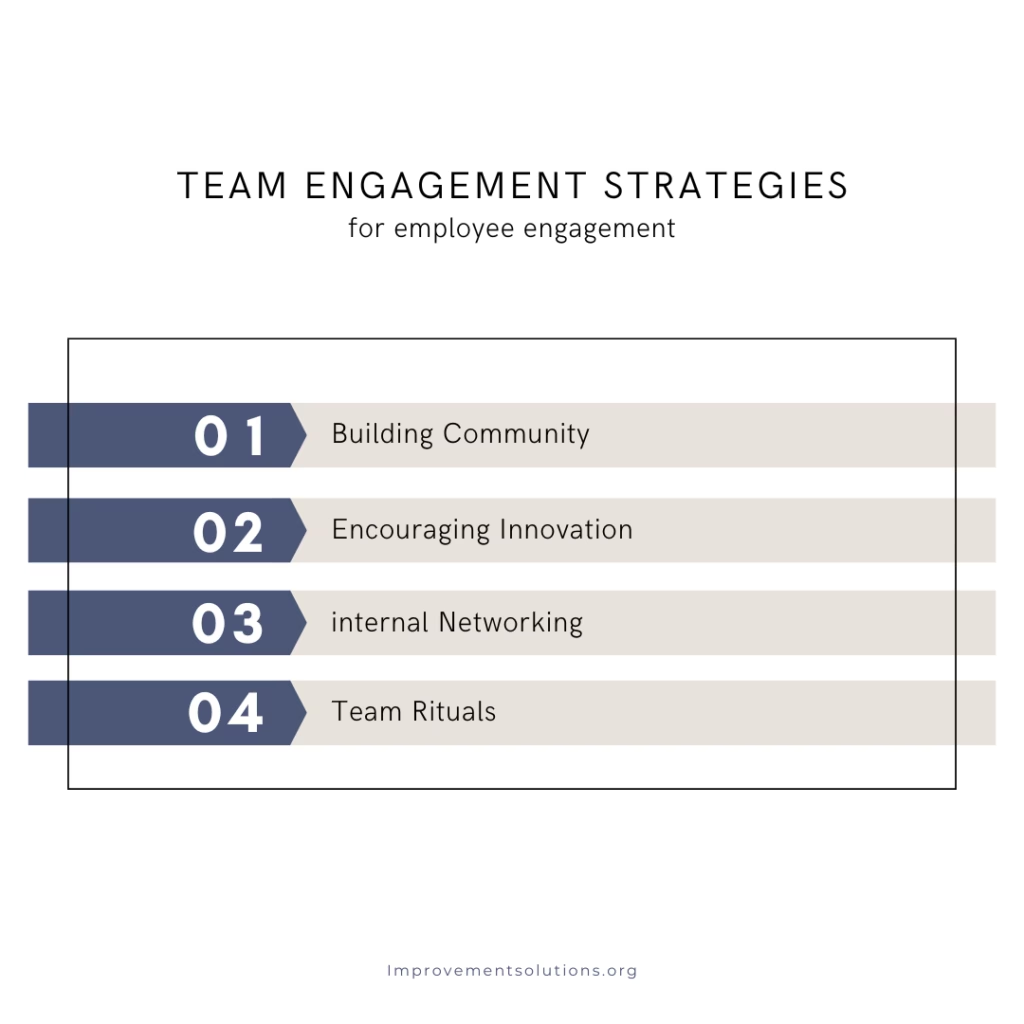
Team Level Engagement Strategies
When we talk about employee engagement, it’s not just about individual efforts, it’s about creating a collective energy within teams.
Team-level engagement strategies focus on strengthening relationships, fostering collaboration, and creating an environment where employees feel a sense of belonging and purpose.
Here are some ways to build that sense of community and drive engagement at the team level:
Building Community
Building a strong sense of community within teams is one of the most powerful ways to boost engagement.
When employees feel like they’re part of a supportive, inclusive team, they’re more likely to show up excited, motivated, and ready to contribute.
A team that feels connected is a team that thrives.
How can you build community within teams?
Whether it’s weekly check-ins, happy hours, or team-building exercises, creating opportunities for employees to connect outside of the usual work tasks is essential.
These activities build trust, improve communication, and give team members opportunities to develop strong personal bonds, which translates to a more engaged, collaborative team.
Whether it’s a project milestone or a big company achievement, taking the time to celebrate successes as a team fosters a sense of collective accomplishment.
Recognizing the team’s hard work and achievements reinforces the idea that everyone’s contribution matters, creating a stronger bond and sense of pride in the team’s efforts.
Encouraging Innovation
Innovation thrives when employees feel empowered to think outside the box, take risks, and bring fresh ideas to the table.
Encouraging innovation at the team level fosters a culture of creativity, collaboration, and problem-solving are key ingredients for a highly engaged workforce.
What does encouraging innovation look like?
Give your team the space to brainstorm, experiment, and explore new ideas without the pressure of deadlines.
This could be in the form of “innovation days” where teams work on projects outside of their regular tasks or even just encouraging employees to dedicate a small portion of their time to exploring new ways of doing things.
Create an environment where all ideas are welcome, regardless of whether they seem big or small.
Team members should feel confident suggesting their ideas without fear of judgment.
Open forums, idea boards, or innovation challenges can provide platforms for everyone to contribute their thoughts.
Innovation often involves taking risks, and it’s important that employees feel comfortable trying new things, even if they might fail.
Reinforce the message that failure is a learning opportunity, not something to be punished.
When employees aren’t afraid to fail, they’re more likely to experiment and bring innovative ideas to the table.
Internal Networking
Internal networking is like creating your own professional social circle within the company.
When employees build relationships across teams, departments, and levels, they’re more likely to feel connected to the company as a whole.
Networking internally allows employees to share ideas, collaborate, and strengthen communication.
How can internal networking drive engagement?
Encourage employees to connect with colleagues in different departments.
This can be through team projects, joint brainstorming sessions, or informal meet-ups.
The more employees get to know each other across teams, the more likely they are to build relationships that can improve communication and problem-solving company-wide.
Organize casual networking events, like coffee chats or lunch mixers, where employees from different teams can meet and learn about each other’s roles.
This not only builds relationships but also sparks new ideas and promotes a sense of community across the company.
Team Rituals
Rituals are a great way to create consistency and deepen bonds within a team.
When employees share experiences together regularly, it builds a sense of unity and tradition that strengthens team engagement.
Something as simple as a shared meal can become a meaningful way for team members to connect.
What are some team rituals that can boost engagement?
A regular team lunch or coffee break can offer a much-needed pause in the day and serve as a chance to socialize.
Whether it’s a weekly potluck or an occasional lunch out, these shared moments create an environment where employees can bond outside of the usual work tasks.
Organize fun team-building activities, such as trivia games, scavenger hunts, or volunteer days.
These rituals not only bring the team closer together but also add a fun, light-hearted aspect to the workday.
Leadership’s Role in Employee Engagement
As a leader, you’re not just there to assign tasks, you’re the one who sets the tone for your team.
Employee engagement doesn’t happen by accident; it’s something you actively create with the way you lead, communicate, and show up every day.
When you lead with intention and care, your team will feel it and that’s when real engagement happens.
So, how do you do that?
It all starts with leading by example. If you’re passionate, motivated, and committed to the work, your team is more likely to feel the same.
Energy is contagious.
But it’s not just about what you do, it’s about how you listen.
When your team feels like they’re truly being heard, they become more invested in the success of the team. Create space for honest, open conversations where everyone feels comfortable sharing their thoughts and ideas.
Along with that, make sure to offer regular feedback and recognition. People want to know they’re doing well, and a little appreciation can go a long way in keeping morale high.
And above all, create a positive and supportive environment.
Be transparent with your team about what’s going on and make sure to empower them to make decisions.
When your team feels trusted and valued, they’ll be more eager to bring their best selves to work every day.
At the end of the day, your role as a leader is to make sure your team is excited to show up and do their best work.
Implementation Roadmap
Now that you’ve got the strategies in place, it’s time to turn them into action. A great plan is only as good as the execution behind it.
So, how do you implement these employee engagement strategies in a way that actually works?
Here are some best practices to keep in mind as you start rolling out your engagement plan:
Best Practices for Success
First, remember that engagement isn’t a one-size-fits-all approach.
What works for one team might not work for another, so it’s important to tailor your strategies to fit the unique needs and culture of your team.
Start by setting clear, measurable goals.
Without a roadmap, it’s hard to know where you’re headed. Define what success looks like for your team (whether it’s increased productivity, better morale, or improved retention) and create specific, achievable targets to work toward.
This helps keep everyone aligned and gives you a clear sense of progress.
Next, make engagement a continuous priority, not a one-time project.
It’s easy to get excited about a new initiative, but keeping momentum requires ongoing effort.
Regularly check in with your team to assess how things are going.
This can be done through surveys, informal conversations, or team meetings. Listen to feedback and be willing to make adjustments as needed.
And lastly, don’t forget to celebrate wins along the way.
Engagement is a journey, and every milestone deserves recognition.
Whether it’s a team achieving a goal or simply hitting a small engagement target, take the time to acknowledge the efforts. Celebrating success boosts morale and reminds everyone that their contributions are valued.
First Steps for Implementation
Now that you’ve got the roadmap and best practices in place, it’s time to take action.
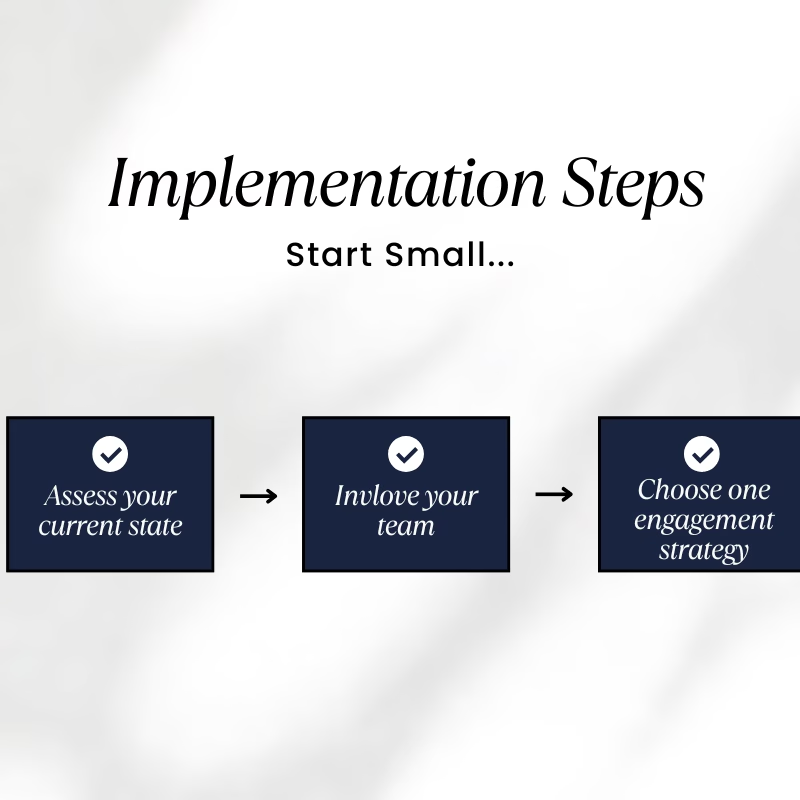
The first steps of implementing an employee engagement strategy can feel like a big leap, but breaking them down into manageable tasks makes it easier to get started and build momentum.
Begin by assessing your current state.
What’s the level of engagement right now?
You can gather this information through employee surveys, one-on-one meetings, or by simply observing the overall atmosphere in the workplace. This gives you a baseline to work from and helps you pinpoint areas that need immediate attention.
Next, involve your team from the get-go.
Don’t try to implement everything in a vacuum.
Engage with employees and ask for their input on what would make them feel more engaged and valued. This creates a sense of ownership and ensures that the strategies you implement will resonate with the people you’re trying to engage.
From there, start small. Choose one or two engagement initiatives to kick off with.
Don’t try to do everything at once. Focus on quality, not quantity.
Whether it’s offering more feedback, setting up a regular check-in meeting, or implementing a wellness program, start small and refine the process as you go.
This way, you’ll have room to adjust and ensure each initiative is successful before adding more.
Common Pitfalls to Avoid
As you begin to implement your engagement strategies, there are a few common pitfalls to watch out for.
Don’t underestimate the importance of consistency.
Engagement isn’t something you can expect to thrive on a one-time push. If your efforts are sporadic, your team will feel that and it can quickly lead to disengagement.
Make sure your efforts are consistent, whether it’s regular feedback, check-ins, or celebrating wins.
Avoid treating employee engagement as a “one-size-fits-all” solution.
Every team is different, and a strategy that works for one group might not resonate with another. Be open to trial and error and be ready to adapt.
Take the time to listen to your employees and make adjustments as needed. The goal is to create an environment where engagement thrives and that looks different for every team.
By staying aware of these pitfalls and taking intentional, thoughtful steps, you can set yourself up for success in boosting engagement.
Remember, it’s a journey, and with patience and consistency, you’ll see the results.
Real World Success Stories
When it comes to employee engagement, there’s no better way to learn than from companies who’ve successfully implemented strategies and seen real results.
Let’s take a look at a few real-world examples to see how organizations have increased engagement and consider what we can learn from their successes.
Examples from Real World Companies
1. Patagonia: Purpose-Driven Culture That Builds Engagement
Imagine walking into an office where the walls are lined with vibrant images of nature and the entire vibe is infused with a sense of adventure.
Now, picture that office offering benefits like on-site childcare, flexible work hours, and a company-wide dedication to environmental activism.
That’s Patagonia in a nutshell.
For years, Patagonia has built its brand around more than just selling outdoor apparel, it’s about a mission to protect the environment.
The company’s commitment to environmental causes is not just a marketing angle, but a genuine passion woven into every aspect of the business.
Employees don’t just clock in to work; they feel a sense of purpose.
And let’s be real, who wouldn’t want to work for a company that’s tackling big environmental challenges head-on while also offering an excellent work-life balance?
By aligning their corporate values with employees’ personal passions, Patagonia has created a culture where engagement is the natural byproduct.
People aren’t just working, they’re part of something bigger.
This deep connection between work and purpose results in a workforce that’s highly engaged, motivated, and loyal. It’s proof that when you give employees a cause they can truly get behind, engagement soars.
2. Hilton: Prioritizing Employee Well-Being for Maximum Engagement
At Hilton, taking care of your employees isn’t just a bonus. It’s an integral part of the company’s success.
With everything from mental health support to flexible scheduling options, Hilton is showing the world that employee well-being isn’t just a buzzword; it’s a business strategy.
Hilton’s approach to employee well-being is holistic, addressing both physical and mental health.
Their benefits include perks like wellness programs, fitness discounts, and paid time off for volunteering, all designed to keep employees happy, healthy, and engaged.
They also provide mental health support, ensuring that employees are equipped to handle life’s challenges outside of work.
Hilton’s commitment to their people has earned them the title of one of the best companies to work for, and it’s easy to see why.
Employees feel valued, supported, and most importantly, cared for.
This engagement translates into a better guest experience, higher employee retention, and ultimately, a stronger business.
Ready to Boost Employee Engagement?
Every step you take to invest in your people will pay off.
From real-world examples like Patagonia and Hilton, we’ve seen how creating an engaged workforce leads to a healthier, more productive company culture.
But engagement doesn’t happen overnight, and it’s not a one-size-fits-all solution.
That’s where we come in!
At Continuous Improvement Solutions, we specialize in crafting customized strategies that will enhance employee engagement in your workplace.
Whether you need help improving communication, creating purpose-driven programs, or implementing well-being initiatives, we’ve got you covered.
Take the first step toward transforming your workplace today.
Contact us to discuss how we can help you foster a more engaged, motivated, and productive team!
